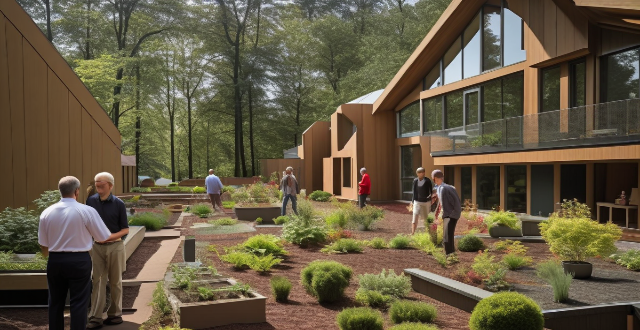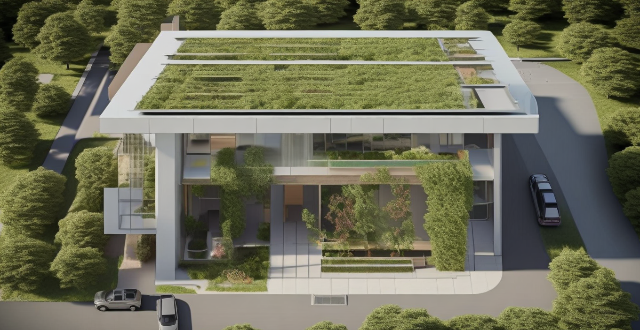Energy Lighting

How do energy-efficient lighting systems work ?
Energy-efficient lighting systems work by using advanced technologies and materials that minimize the amount of energy required to produce light. They include LED lighting, compact fluorescent lamps (CFLs), and smart lighting controls. LEDs convert up to 80% of their energy into light, have a long lifespan, and generate less heat than traditional bulbs. CFLs use about 75% less energy than incandescent bulbs and come in various colors and styles. Smart lighting controls automatically adjust the amount of light based on occupancy levels or desired brightness, reducing unnecessary energy waste. Overall, these systems offer significant advantages over traditional lighting methods in terms of energy savings, longevity, and safety.

How do I choose the right energy-efficient lighting system for my needs ?
Choosing the right energy-efficient lighting system involves assessing your needs, considering options like LED and solar lighting, evaluating energy efficiency ratings, and factoring in maintenance costs.

What are the benefits of energy-efficient lighting systems ?
Energy-efficient lighting systems offer multiple benefits, including reducing energy consumption and positively impacting the environment, economy, and overall well-being. They help lower greenhouse gas emissions and promote sustainability by lasting longer and using recyclable materials. Economically, these systems reduce energy costs and require fewer replacements over time, making them cost-effective. They also provide better visual comfort, reducing eye strain and increasing productivity, while producing less heat for a more comfortable environment. Upgrading to energy-efficient lighting systems contributes to a more sustainable future for all.

How do energy-efficient lighting systems compare to traditional lighting systems in terms of performance and quality ?
Energy-efficient lighting systems outperform traditional lighting in luminous efficacy, lifespan, and color rendering index. They often offer dimming capabilities and instant on/off features. In terms of quality, energy-efficient options are more environmentally friendly, cost-effective over time, maintain consistent light quality, generate less heat, and provide a wider range of design options. Overall, energy-efficient lighting offers superior performance and quality compared to traditional systems.

What are the different types of energy-efficient lighting systems available ?
Energy-efficient lighting systems reduce energy consumption while providing adequate light. They include incandescent bulbs, halogen bulbs, compact fluorescent lamps (CFLs), LED lights, solar lights, and smart lighting systems. Each has its advantages and disadvantages, so it's important to choose the right type based on needs and budget.

Can energy-efficient lighting systems be used in commercial buildings as well as residential homes ?
Energy-efficient lighting systems offer significant energy savings, reduced maintenance costs, and environmental benefits. LED, CFL, and halogen lighting are common types of energy-efficient lighting systems that can be used in both commercial buildings and residential homes. By choosing an energy-efficient lighting system, users can contribute to a more sustainable future while also saving money on utility bills.

Are there any government incentives for installing energy-efficient lighting systems ?
Governments worldwide are offering incentives to encourage the installation of energy-efficient lighting systems. These incentives include tax credits, rebates, grants, and subsidies aimed at reducing energy consumption, lowering greenhouse gas emissions, and promoting sustainable development. Types of government incentives for energy-efficient lighting systems include: 1. Tax Credits: Allow businesses and individuals to deduct a portion of the cost of installing energy-efficient lighting from their taxable income. 2. Rebates: Provide a direct payment to businesses or individuals who install energy-efficient lighting systems. 3. Grants: Financial awards given to support the installation of energy-efficient lighting systems without requiring any initial investment from the recipient. 4. Subsidies: Financial assistance provided by governments to make energy-efficient lighting systems more affordable through mechanisms like low-interest loans and interest rate subsidies. Benefits of energy-efficient lighting systems include significant energy savings, reduced environmental impact, and long-term cost savings. Despite the higher initial cost compared to traditional lighting systems, the reduced energy consumption and maintenance costs can offset the investment over time, making these systems a wise financial decision.

How much money can I save by switching to an energy-efficient lighting system ?
Switching to an energy-efficient lighting system can result in significant cost savings over time, depending on several factors such as the type of lighting system currently used, the size of the space, and the hours of operation. Comparing the costs of different lighting systems reveals that LED bulbs offer the lowest operating costs due to their minimal energy consumption. Switching to LED bulbs can also provide other benefits such as reduced environmental impact, longer lifespan, improved light quality, safety, and reliability.

What is the importance of lighting in sports stadium design ?
Lighting plays a crucial role in the design of sports stadiums, ensuring safety and visibility for athletes and enhancing the overall experience for spectators. Proper lighting allows athletes to clearly see the playing field and make accurate judgments about distance, speed, and direction, leading to better performance. Well-designed lighting systems also minimize glare and reflections, reducing eye strain for spectators and providing an enjoyable viewing experience. Energy efficiency and cost savings are important considerations in sports stadium lighting design. LED lighting technology consumes less energy compared to traditional lighting sources and has a longer lifespan, reducing maintenance costs and frequency of replacement. Smart lighting systems can adjust brightness levels based on natural light availability and be controlled remotely, further reducing energy consumption. Lighting also plays a role in creating atmosphere and ambiance within sports stadiums. Different colors of lighting can evoke different emotions among spectators, creating a unique atmosphere for each event. Customized lighting schemes can be used to promote team colors or sponsor logos, enhancing brand recognition. Advanced lighting systems can create dynamic light shows during halftime or between events, adding excitement and entertainment value. Interactive lighting features can engage spectators and create a sense of community within the stadium. In conclusion, lighting is a vital aspect of sports stadium design that ensures safety and visibility, promotes energy efficiency and cost savings, and enhances the overall atmosphere and ambiance of the event. As technology continues to advance, it is essential for stadium designers to stay updated with the latest trends and innovations in lighting systems to provide the best possible experience for both athletes and spectators alike.

Are there any drawbacks to using energy-efficient lighting systems ?
Energy-efficient lighting systems offer reduced energy consumption and cost savings, but come with potential drawbacks such as higher upfront costs, compatibility issues, color quality concerns, maintenance and disposal challenges, and potential health risks. It's important to weigh the pros and cons carefully before making a final choice.

How can we reduce energy consumption in households ?
Reducing energy consumption in households is crucial for saving money and promoting environmental sustainability. Effective methods include switching to energy-efficient appliances, improving insulation, using LED lighting, optimizing heating and cooling, saving water, unplugging electronics, utilizing natural lighting and ventilation, cooking efficiently, and adopting energy-saving habits in laundry and cleaning. Educating family members and monitoring energy usage are also key steps towards reducing a household's energy consumption.

How long does it take for an energy-efficient lighting system to pay for itself ?
The article discusses the financial benefits of investing in energy-efficient lighting systems and how long it takes for such an investment to pay off. It highlights that the payback period depends on several factors, including the cost of the system, energy savings achieved, usage patterns, and electricity rates. The article provides a step-by-step guide to calculate the payback period and offers an example calculation. Overall, the article emphasizes the long-term financial advantages of adopting energy-efficient lighting solutions.

What role does lighting play in capturing the perfect food photo ?
The role of lighting in food photography is crucial for capturing the perfect photo. Key aspects to consider include color temperature and mood, directionality and shadows, intensity and exposure, background and ambiance, and experimentation and creativity. Warm lighting enhances warm, comfort foods while cool lighting complements cold dishes like salads or seafood. Natural light provides soft, even illumination while artificial light allows for more control over directionality. Bright lighting captures vibrant colors but can cause overexposure, while dim lighting creates a moody effect but may require longer exposure times. Simple backgrounds with subtle lighting accents allow the food to be the main focus, while elaborate setups incorporate additional lighting elements for an immersive dining experience. Experimenting with multiple light sources and using reflectors and diffusers can achieve a balanced and pleasing result. Mastering lighting techniques can elevate food photos from ordinary to extraordinary.

What are the most popular climate-friendly products in the market today ?
The article discusses popular climate-friendly products available in the market today. These include solar panels, electric cars, smart thermostats, and LED light bulbs. Solar panels are a renewable energy source with low maintenance costs and a long lifespan. They reduce reliance on fossil fuels and have government incentives for installation. The benefits of using solar panels include decreased carbon footprint, lower electricity bills, energy independence, and a cleaner environment. Electric cars have lower greenhouse gas emissions, high efficiency, low operational costs, advanced technology features, and a wide range of models available. They reduce air pollution, offer a quieter driving experience, provide potential tax credits and rebates, and support the transition to renewable energy sources. Smart thermostats optimize energy efficiency, have remote control capabilities, learning algorithms to adapt to user preferences, compatibility with various HVAC systems, and easy installation process. They significantly reduce heating and cooling costs, improve indoor comfort levels, minimize wasted energy usage when not at home or sleeping, and contribute to a smaller carbon footprint through energy conservation. LED light bulbs have a long lifespan compared to traditional bulbs, low energy consumption, bright natural light quality, variety of styles and colors available, and compatibility with smart home systems for automated lighting control. They drastically reduce electricity usage for lighting needs, lessen the need for frequent replacements due to longer lifespan, offer customizable lighting options for different moods and tasks, and support environmental conservation efforts by using less energy overall.

What are the most effective ways to improve energy efficiency in buildings ?
Improving energy efficiency in buildings is essential for environmental and financial reasons. Effective methods include proper insulation, efficient lighting solutions, using energy-efficient appliances, smart controls, harnessing renewable energy sources, and conserving water. These strategies not only reduce operational costs but also create healthier spaces while contributing to sustainability.

How does ecological design impact energy efficiency in buildings ?
Ecological design significantly impacts energy efficiency in buildings through various strategies like passive solar design, advanced insulation, renewable energy sources, energy-efficient appliances, water conservation, and sustainable material choices. These practices reduce energy consumption, lower operational costs, and minimize environmental harm.

How can existing buildings be retrofitted for energy efficiency ?
Retrofitting existing buildings for energy efficiency involves several strategies, including conducting an energy audit, upgrading insulation, installing energy-efficient windows and lighting systems, optimizing HVAC systems, using energy-efficient appliances, implementing water-saving measures, sealing air leaks, investing in renewable energy sources, and encouraging energy-conscious behavior. These steps can lead to cost savings, increased comfort, and reduced environmental impact.

What are some innovative technologies being used in energy-efficient buildings ?
Innovative technologies are transforming energy efficiency in buildings. Smart building management systems optimize energy usage through sensors and AI, while green roofs/walls provide insulation and improve air quality. Solar windows generate electricity without obstructing views, and high-performance insulation materials like aerogel trap heat effectively. Energy-efficient LED lighting reduces power consumption and maintenance costs. These advancements contribute to a more sustainable built environment.

How do energy-efficient buildings affect a company's bottom line ?
Energy-efficient buildings positively impact a company's profitability by reducing energy costs, enhancing employee productivity, and improving environmental performance. These benefits include lower utility bills from reduced energy consumption, increased revenue from healthier and more productive employees, and improved corporate image that attracts talent and eco-conscious customers. Despite higher initial investment, the long-term advantages make such expenditures beneficial for sustainable business growth.

What are the current building energy efficiency standards ?
The text discusses building energy efficiency standards, which are regulations and guidelines designed to reduce energy consumption. These standards promote sustainable development, reduce greenhouse gas emissions, and improve indoor air quality. The text lists seven key areas for improving energy efficiency: insulation and air tightness, heating, ventilation, and air conditioning systems, lighting systems, renewable energy sources, water efficiency, building materials and construction practices, and energy management and monitoring. Each area includes specific strategies and technologies that can be employed to increase energy efficiency.

How can I make my home more energy-efficient ?
Making your home more energy-efficient can reduce your carbon footprint, save money on utility bills, and improve the comfort of your living space. To achieve this, consider proper insulation, improving window and door performance, optimizing heating and cooling systems, using energy-efficient appliances and electronics, and switching to energy-efficient lighting options. By implementing these strategies, you can enjoy the benefits of a more sustainable future.

How does a home energy audit help in saving on electricity ?
A home energy audit helps identify inefficiencies and suggests upgrades, leading to electricity savings. It includes checks on insulation, air leakage, ductwork, appliance efficiency, and lighting systems. It also promotes behavioral changes and renewable energy options, providing a prioritized plan for improvements along with information on financial incentives.

What are the benefits of energy-efficient buildings ?
Energy-efficient buildings offer numerous benefits, including environmental advantages like reduced greenhouse gas emissions and conservation of natural resources, economic savings such as lower energy bills and increased property value, health improvements through better indoor comfort and air quality, and social effects like job creation and community standards. These buildings are a smart investment that provide long-term savings and promote a greener planet.

What are the most effective methods for improving industrial energy efficiency ?
The most effective methods for improving industrial energy efficiency include process optimization, using energy-efficient equipment, harnessing renewable energy sources, thermal management, power management, employee training and awareness, employing energy information systems, and complying with policy and regulatory standards. These methods can reduce operational costs, conserve resources, and minimize environmental impact.

How does the design of a building impact its energy efficiency ?
This text discusses the impact of building design on energy efficiency, focusing on orientation and layout, insulation and airtightness, windows and doors, lighting and electrical systems, and HVAC systems. It highlights that a well-designed building can significantly reduce energy consumption and improve indoor comfort, while a poorly designed one can lead to high energy costs and discomfort for occupants. The text provides various strategies and considerations for each aspect of building design to achieve energy efficiency.

What are some innovative methods for improving industrial energy efficiency ?
Innovative Methods for Improving Industrial Energy Efficiency - Advanced Technologies: AI and Machine Learning for predictive maintenance and optimization of energy consumption, IoT sensor networks and remote control systems. - Process Optimization Techniques: Heat Recovery Systems like energy recuperation and Combined Heat and Power (CHP), process integration through industrial symbiosis and lean manufacturing. - Building Design and Management: Green architecture using eco-friendly materials and natural lighting/ventilation, Smart Building Management Systems with automated controls and energy management software. - Employee Training and Involvement: Educational programs on energy conservation, skill development for new technologies, participation incentives through reward systems and team challenges.

How do energy-efficient buildings contribute to sustainability ?
Energy-efficient buildings contribute to sustainability by reducing energy consumption, decreasing greenhouse gas emissions, and conserving natural resources. These buildings use less energy for heating, cooling, and lighting, resulting in lower energy bills and reduced carbon footprints. They also incorporate features like improved ventilation systems and water-saving technologies to improve air quality and conserve water resources. By using renewable materials and minimizing waste, these buildings help conserve natural resources and reduce landfill waste. Overall, energy-efficient buildings play a crucial role in achieving sustainability and protecting our planet for future generations.

What are the most common features of energy-efficient buildings ?
Energy-efficient buildings are designed to reduce energy consumption and minimize their impact on the environment. Some of the most common features of these buildings include insulation, energy-efficient windows, solar panels, energy-efficient lighting, high-efficiency HVAC systems, rainwater harvesting systems, green roofs and walls, energy monitoring systems, energy-efficient appliances, and natural ventilation. These features can significantly lower heating and cooling costs, reduce the demand for municipal water supplies, and improve indoor air quality.

What are the key factors to consider when planning an energy-efficient building project ?
The text provides a summary of key factors that should be considered when planning an energy-efficient building project. These factors include site selection and orientation, building design and construction, and energy sources and consumption. The location and orientation of the building on the site can have a significant impact on its energy efficiency, as well as the design and construction of the building itself. Consideration should also be given to the sources of energy used by the building and how that energy is consumed. By considering these key factors during the planning stages of an energy-efficient building project, it is possible to create a building that is comfortable, functional, environmentally responsible, and economically sustainable over its lifetime.